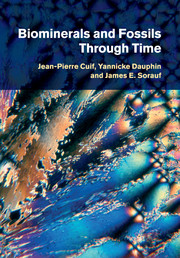Book contents
- Frontmatter
- Contents
- Preface
- Introduction: Milestones in the study of biominerals
- 1 The concept of microstructural sequence exemplified by mollusc shells and coral skeletons
- 2 Compositional data on mollusc shells and coral skeletons
- 3 Origin of microstructural diversity
- 4 Diversity of structural patterns and growth modes in skeletal Ca-carbonate of some plants and animals
- 5 Connecting the Layered Growth and Crystallization model to chemical and physiological approaches
- 6 Microcrystalline and amorphous biominerals in bones, teeth, and siliceous structures
- 7 Collecting better data from the fossil record through the critical analysis of fossilized biominerals
- 8 Results and perspectives
- List of references
- Name index
- Subject index
1 - The concept of microstructural sequence exemplified by mollusc shells and coral skeletons
Similarity of growth mode and skeletogenesis at the micrometer scale
Published online by Cambridge University Press: 10 January 2011
- Frontmatter
- Contents
- Preface
- Introduction: Milestones in the study of biominerals
- 1 The concept of microstructural sequence exemplified by mollusc shells and coral skeletons
- 2 Compositional data on mollusc shells and coral skeletons
- 3 Origin of microstructural diversity
- 4 Diversity of structural patterns and growth modes in skeletal Ca-carbonate of some plants and animals
- 5 Connecting the Layered Growth and Crystallization model to chemical and physiological approaches
- 6 Microcrystalline and amorphous biominerals in bones, teeth, and siliceous structures
- 7 Collecting better data from the fossil record through the critical analysis of fossilized biominerals
- 8 Results and perspectives
- List of references
- Name index
- Subject index
Summary
At the time that Heinz Lowenstam began an investigation bearing on the different minerals that living organisms can produce, only a dozen or so biogenic minerals were known. Thirty years later, their number surpasses 60. Well before the appearance of the synthesis uniting the essential data that had been established during the 1980s (Lowenstam and Weiner 1989), Lowenstam had proposed (1981) a fundamental distinction concerning the mode of formation of biogenic minerals, and more particularly the precision of the controls on their deposition exerted by the producing organism. Lowenstam proposed then to distinguish the “matrix-mediated minerals,” characterized by formation very precisely controlled by the action of an organic component specifically produced, and those that, although equally produced by a living organism, are developed in a more autonomous way; they are only “biologically induced.” In these last, mineral elements can be developed according to methods and arrangements quite close to those that can be observed in purely chemical precipitated materials.
Among the calcified structures belonging to this category were placed the calcareous skeletons produced by corals. This opposition between molluscan shells, examples of “matrix-mediated minerals,” and coral skeletal carbonate has remained generally accepted and very recently has still been formulated in reference journals (Veis 2005). This is however, truly surprising. The precision of the biological control on the skeleton by the coral polyps had been well established at the end of the nineteenth century by M. Ogilvie (1895, 1896), who carried out a pioneering study of the specific arrangements of the fibrous aragonite units there.
- Type
- Chapter
- Information
- Biominerals and Fossils Through Time , pp. 11 - 56Publisher: Cambridge University PressPrint publication year: 2010



